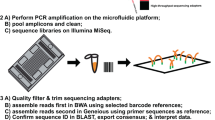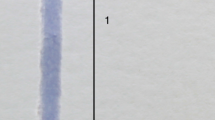Abstract
We describe a modification of the DNA extraction method, in which cetyltrimethylammonium bromide (CTAB) is used to extract nucleic acids from plant tissues. In contrast to the original method, the modified CTAB procedure is faster, omits the selective precipitation and CsCl gradient steps, uses less expensive and toxic reagents, requires only inexpensive laboratory equipment and is more readily adapted to high-throughput DNA extraction. This protocol yields approximately 5–30 μg of total DNA from 200 mg of tissue fresh weight, depending on plant species and tissue source. It can be completed in as little as 5–6 h.
Note: In the version of this article initially published online, the name of the coauthor S Krasnyanski was misspelled as S Krasynanski. This error has been corrected in all versions of the article.
This is a preview of subscription content, access via your institution
Access options
Subscribe to this journal
Receive 12 print issues and online access
$259.00 per year
only $21.58 per issue
Buy this article
- Purchase on Springer Link
- Instant access to full article PDF
Prices may be subject to local taxes which are calculated during checkout


Similar content being viewed by others
Change history
31 January 2007
In the version of this article initially published online, the name of the coauthor S Krasnyanski was misspelled as S Krasynanski. This error has been corrected in all versions of the article.
References
Murray, M.G. & Thompson, W.F. Rapid isolation of high molecular weight plant DNA. Nucleic Acids Res. 8, 4321–4325 (1980).
Taylor, B. & Powell, A. Isolation of plant DNA and RNA. BRL Focus 4, 4–6 (1982).
Rogers, S.O. & Bendich, A.J. Extraction of DNA from milligram amounts of fresh, herbarium and mummified plant-tissues. Plant Mol. Biol. 5, 69–76 (1985).
Watson, J.C. & Thompson, W.F. Purification and restriction endonuclease analysis of plant nuclear-DNA. Method Enzymol. 118, 57–75 (1986).
Doyle, J.J. & Doyle, J.L. A rapid DNA isolation procedure for small quantities of fresh leaf tissue. Phytochem. Bull. 19, 11–15 (1987).
Shen, Y.J. et al. Development of genome-wide DNA polymorphism database for map-based cloning of rice genes. Plant Physiol. 135, 1198–1205 (2004).
Yang, Z.P., Gilbert, J., Fedak, G. & Somers, D.J. Genetic characterization of QTL associated with resistance to Fusarium head blight in a doubled-haploid spring wheat population. Genome 48, 187–196 (2005).
Jena, K.K., Jeung, J.U., Lee, J.H., Choi, H.C. & Brar, D.S. High-resolution mapping of a new brown planthopper (BPH) resistance gene, Bph18(t), and marker-assisted selection for BPH resistance in rice (Oryza sativa L.). Theor. Appl. Genet. 112, 288–297 (2006).
Feng, D.S., Xia, G.M., Zhao, S.Y. & Chen, F.G. Two quality-associated HMW glutenin subunits in a somatic hybrid line between Triticum aestivum and Agropyron elongatum. Theor. Appl. Genet. 110, 136–144 (2004).
Mannerlof, M. & Tenning, P. Screening of transgenic plants by multiplex PCR. Plant Mol. Biol. Rep. 15, 38–45 (1997).
Holm, P.B., Olsen, O., Schnorf, M., Brinch-Pedersen, H. & Knudsen, S. Transformation of barley by microinjection into isolated zygote protoplasts. Transgenic Res. 9, 21–32 (2000).
Sanan-Mishra, N., Pham, X.H., Sopory, S.K. & Tuteja, N. Pea DNA helicase 45 overexpression in tobacco confers high salinity tolerance without affecting yield. Proc. Natl. Acad. Sci. USA 102, 509–514 (2005).
Oliveira, A.C. et al. Quantification of Xylella fastidiosa from citrus trees by real-time polymerase chain reaction assay. Phytopathology 92, 1048–1054 (2002).
Brandfass, C. & Karlovsky, P. Simultaneous detection of Fusarium culmorum and F. graminearum in plant material by duplex PCR with melting curve analysis. BMC Microbiol. 6 (2006).
Ritala, A., Nuutila, A.M., Aikasalo, R., Kauppinen, V. & Tammisola, J. Measuring gene flow in the cultivation of transgenic barley. Crop Sci. 42, 278–285 (2002).
Foti, N., Onori, R., Donnarumma, E., Santis, B. & Miraglia, M. Real-time PCR multiplex method for the quantification of Roundup Ready soybean in raw material and processed food. Eur. Food Res. Technol. 222, 209–216 (2006).
Flagel, L. et al. Inexpensive, high throughput microplate format for plant nucleic acid extraction: suitable for multiplex Southern analyses of transgenes. Crop Sci. 45, 1985–1989 (2005).
Caccavo, F. et al. Geobacter sulfurreducens sp-nov, a hydrogen-oxidizing and acetate-oxidizing dissimilatory metal-reducing microorganism. Appl. Environ. Microbiol. 60, 3752–3759 (1994).
Xu, Q. et al. The cellulosome system of Acetivibrzo cellulolyticus includes a novel type of adaptor protein and a cell surface anchoring protein. J. Bacteriol. 185, 4548–4557 (2003).
Saleh, A.A. & Leslie, J.E. Cephalosporium maydis is a distinct species in the Gaeumannomyces–Harpophora species complex. Mycologia 96, 1294–1305 (2004).
Thuan, N., Bigirimana, J., Roumen, E., Van Der Straeten, D. & Hofte, M. Molecular and pathotype analysis of the rice blast fungus in North Vietnam. Eur. J. Plant Pathol. 114, 381–396 (2006).
Shahjahan, R.M., Hughes, K.J., Leopold, R.A. & DeVault, J.D. Lower incubation temperature increases yield of insect genomic DNA isolated by the CTAB method. Biotechniques 19, 332–334 (1995).
Appelbee, A.J., Frederick, L.M., Heitman, T.L. & Olson, M.E. Prevalence and genotyping of Giardia duodenalis from beef calves in Alberta, Canada. Vet. Parasitol. 112, 289–294 (2003).
Chiang, Y.C. et al. Contrasting phylogeographical patterns between mainland and island taxa of the Pinus luchuensis complex. Mol. Ecol. 15, 765–779 (2006).
Shimono, A., Ueno, S., Tsumura, Y. & Washitani, I. Spatial genetic structure links between soil seed banks and above-ground populations of Primula modesta in subalpine grassland. J. Ecol. 94, 77–86 (2006).
Nasrallah, M.E., Liu, P., Sherman-Broyles, S., Boggs, N.A. & Nasrallah, J.B. Natural variation in expression of self-incompatibility in Arabidopsis thaliana: implications for the evolution of selfing. Proc. Natl. Acad. Sci. USA. 101, 16070–16074 (2004).
Zhang, P.Y., Tan, H.T.W., Pwee, K.H. & Kumar, P.P. Conservation of class C function of floral organ development during 300 million years of evolution from gymnosperms to angiosperms. Plant J. 37, 566–577 (2004).
Alonso, J.M. & Ecker, J.R. Moving forward in reverse: genetic technologies to enable genome-wide phenomic screens in Arabidopsis. Nat. Rev. Genet. 7, 524–536 (2006).
He, G.M. et al. Haplotype variation in structure and expression of a gene cluster associated with a quantitative trait locus for improved yield in rice. Genome Res. 16, 618–626 (2006).
Ye, J. et al. A simple and efficient method for extracting DNA from old and burned bone. J. Forensic Sci. 49, 754–759 (2004).
Wulff, E.G., Torres, S. & Gonzalez Vigil, E. Protocol for DNA extraction from potato tubers. Plant Mol. Biol. Rep. 20, 187a–187e (2002).
Tel-Zur, N., Abbo, S., Myslabodski, D. & Mizrahi, Y. Modified CTAB procedure for DNA isolation from epiphytic cacti of the genera Hylocereus and Selenicereus (Cactaceae). Plant Mol. Biol. Rep. 17, 249–254 (1999).
Cheng, Y.-J., Guo, W.-W., Yi, H.-L., Pang, X.-M. & Deng, X. An efficient protocol for genomic DNA extraction from citrus species. Plant Mol. Biol. Rep. 21, 177a–177g (2003).
Huang, J., Ge, X. & Sun, M. Modified CTAB protocol using a silica matrix for isolation of plant genomic DNA. Biotechniques 28, 432–434 (2000).
Sharma, A.D., Gill, P.K. & Singh, P. DNA isolation from dry and fresh samples of polysaccharide-rich plants. Plant Mol. Biol. Rep. 20, 415a–415f (2002).
Yang, H.Y., Nairn, J. & Ozias-Akins, P. Transformation of peanut using a modified bacterial mercuric ion reductase gene driven by an actin promoter from Arabidopsis thaliana. J. Plant Physiol. 160, 945–952 (2003).
Puchooa, D. A simple, rapid and efficient method for the extraction of genomic DNA from lychee (Litchi chinensis Sonn.). Afr. J. Biotechnol. 3, 253–255 (2004).
Bekesiova, I., Nap, J.P. & Mlynarova, L. Isolation of high quality DNA and RNA from leaves of the carnivorous plant Drosera rotundifolia. Plant Mol. Biol. Rep. 17, 269–277 (1999).
Stange, C., Prehn, D. & Arce-Johnson, P. Isolation of Pinus radiata Genomic DNA suitable for RAPD analysis. Plant Mol. Biol. Rep. 16, 1–8 (1998).
Pirttila, A.M., Hirsikorpi, M., Kamarainen, T., Jaakola, L. & Hohtola, A. DNA isolation methods for medicinal and aromatic plants. Plant Mol. Biol. Rep. 19, 273a–273f (2001).
Acknowledgements
This work was funded by grants from the National Science Foundation (520630 and 524026).
Author information
Authors and Affiliations
Corresponding author
Ethics declarations
Competing interests
The authors declare no competing financial interests.
Rights and permissions
About this article
Cite this article
Allen, G., Flores-Vergara, M., Krasynanski, S. et al. A modified protocol for rapid DNA isolation from plant tissues using cetyltrimethylammonium bromide. Nat Protoc 1, 2320–2325 (2006). https://doi.org/10.1038/nprot.2006.384
Published:
Issue Date:
DOI: https://doi.org/10.1038/nprot.2006.384
This article is cited by
-
Haplotype-resolved genome assembly provides insights into evolutionary history of the Actinidia arguta tetraploid
Molecular Horticulture (2024)
-
Wheat Pm55 alleles exhibit distinct interactions with an inhibitor to cause different powdery mildew resistance
Nature Communications (2024)
-
Genetic diversity of grain yield traits and identification of a grain weight gene SiTGW6 in foxtail millet
Theoretical and Applied Genetics (2024)
-
The complete chloroplast genome sequence of Artemisia stechmanniana (Asteraceae): genome structure and phylogenetic analysis
Biologia (2024)
-
Comparative complete chloroplast genome of Geum japonicum: evolution and phylogenetic analysis
Journal of Plant Research (2024)
Comments
By submitting a comment you agree to abide by our Terms and Community Guidelines. If you find something abusive or that does not comply with our terms or guidelines please flag it as inappropriate.



